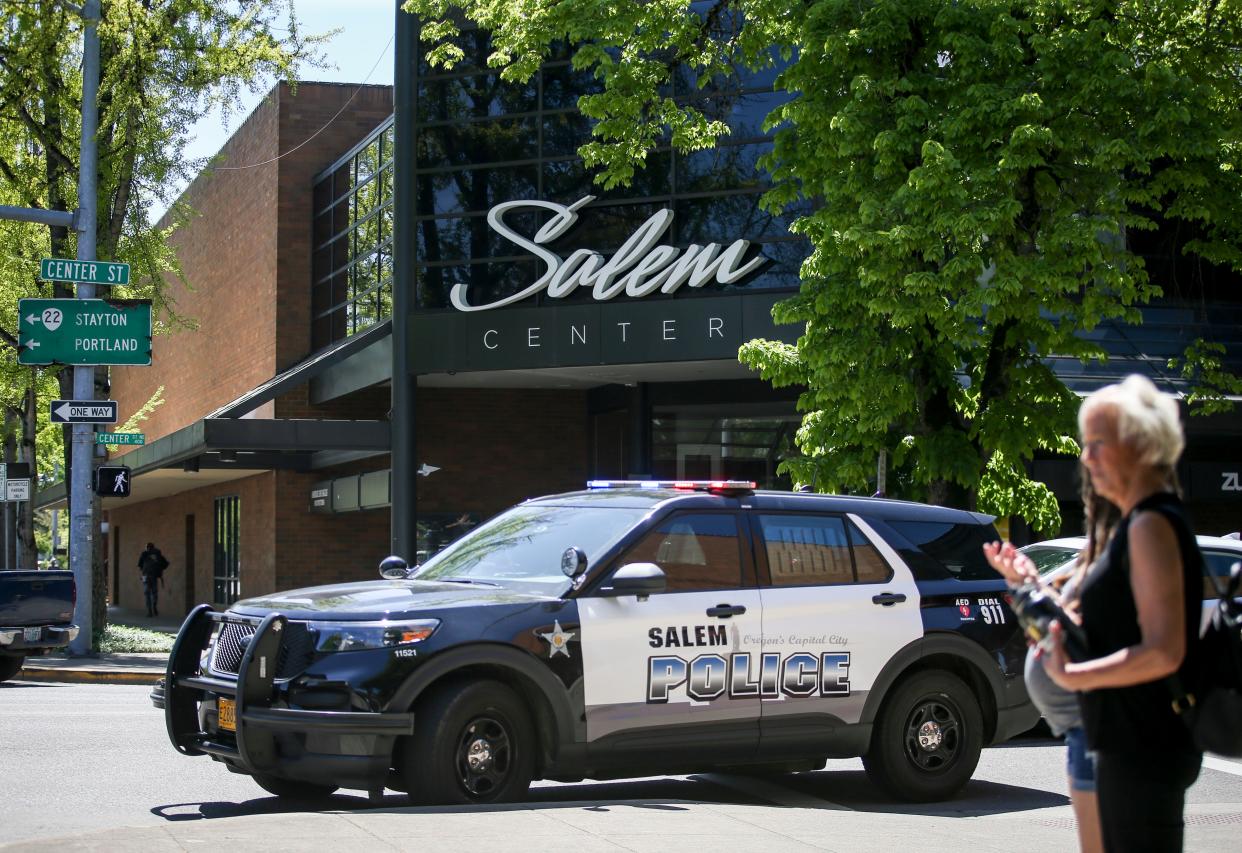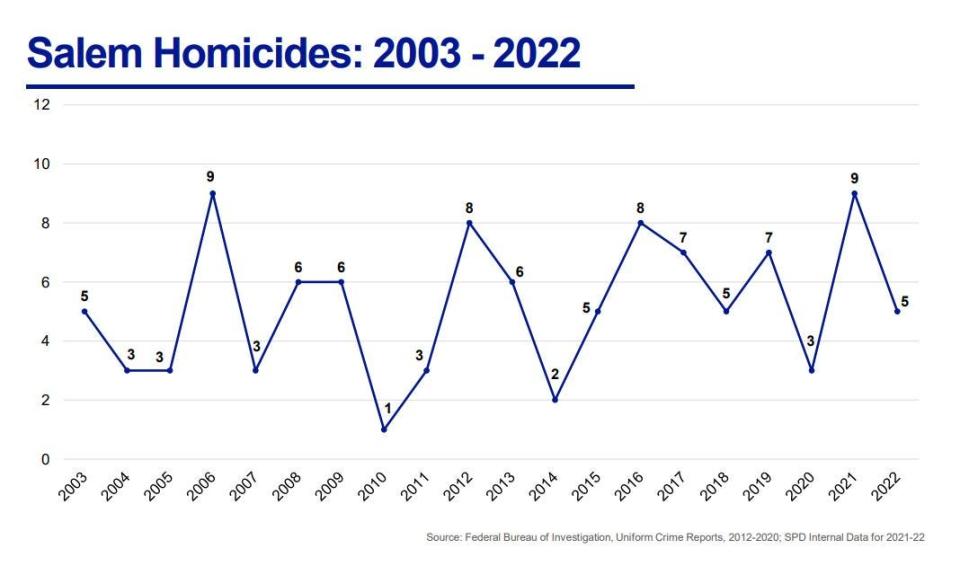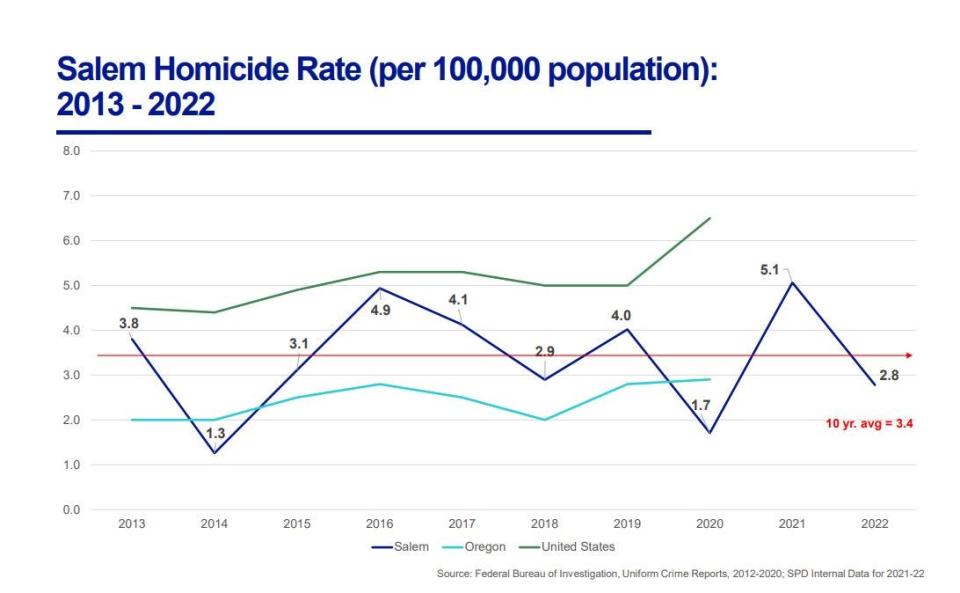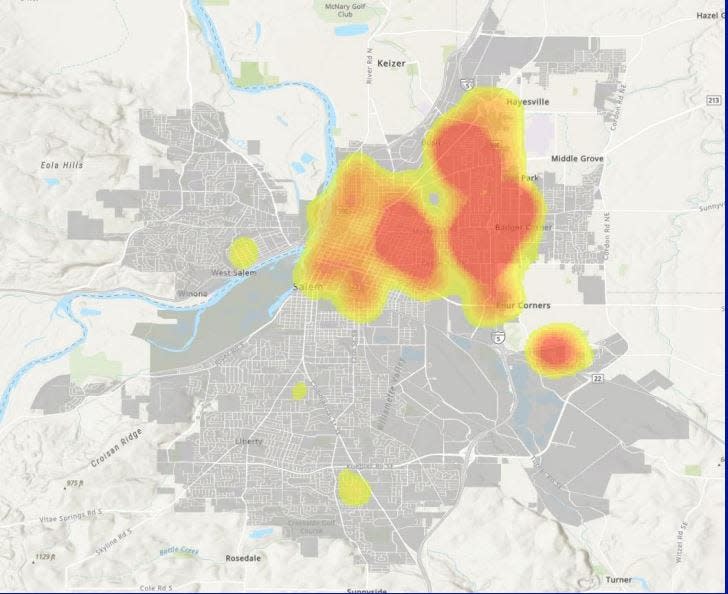Salem gun violence report paints grim trend for crime. Here are the report's key takeaways

This story was updated at 7:55 p.m. Monday
A recently released report on gun violence in Salem paints a grim trend for crime in the capital city, including a 100% increase in shootings over five years, a homicide rate hovering above the statewide average and a three-fold increase in juvenile crime.
"Salem's rise in shootings and the longer-term upward trend of violent crime are issues that affect us all," Salem Police Chief Trevor Womack said in a statement. "For some, the impact is permanent and profound."
Womack said one of the first steps to combatting the increase in violence is to understand the problem — who are the suspects, who are the victims and where crimes are happening most.
The Salem Police Department commissioned the Gun Violence Problem Analysis to conduct a detailed review of local gun violence.
For the analysis, the department sought out Dr. Lisa Barao, a noted researcher with a Ph.D. in criminology and justice policy, and Chris Mastroianni, a law enforcement professional with experience leading violence reduction strategies.
Police officials, law enforcement partners and the Salem City Council meet Monday evening for a work session to review the findings.
Among the findings are a 10-year homicide rate in Salem higher than the statewide average and that of similarly sized cities such as Eugene and Gresham.
Other key takeaways include:
100% increase in shootings in Salem since 2018
From 2018 to 2022, the number of shootings in the city doubled.
Salem had two fatal shootings and eight nonfatal incidents in 2018. In 2022, 16 nonfatal and four fatal shootings were reported.
The increase has been attributed to everything from the COVID-19 pandemic to social unrest. Law enforcement highlighted several possible contributing factors but was quick to point out that the true cause and impact could not be singled out.

In 2019, the Salem Police Department disbanded its Gang Enforcement Team.
"Several City and County personnel noted that this had impacted the ability of criminal justice partners to develop and share quality gang intelligence," the report said, adding the contemporary gang environment of social media and online disputes made it difficult to set up intervention programs.
Partners also pointed to Senate Bill 1008 going into effect in 2020. The bill eliminated mandatory waivers to adult court for Measure 11 crimes and implemented practices to reduce sentence length for offenders under 18.
The COVID-19 pandemic impacted a variety of criminal justice system programs, supervision and services for high-risk youth at schools. All of these factors occurred around the same time of civil unrest and a "crisis of legitimacy" of police following the murder of George Floyd, according to criminal justice researchers.
Other data collected by Salem Police could indicate that the uptick in violent crime might be slowing down. The first six months of 2023 showed fewer violent crimes than the first six months of the previous year — 400 in 2023 versus 273 in 2022.
How does Salem's violent crime rate compare with other Oregon cities?
A 2023 analysis of Salem and several other Oregon cities showed Salem had a much higher violent crime rate than Eugene, Gresham, Bend, Hillsboro and Beaverton.
The analysis released this month underscored this. The city's homicide rate in 2019 was more than double Eugene's and Medford's rate. Even Gresham, which borders Portland, had a 2.7 per 100,000 homicide rate compared to Salem's four per 100,000 rate.

Despite consistently being higher than the state average, the homicide rate in Salem is still below the national average and well below the rates in "peer cities" such as Wichita, Kansas; Fort Wayne, Indiana; and Albuquerque, New Mexico; highlighted in the report.
Salem is not the only city that has seen an uptick in violent crime in recent years. Nationwide, cities reported an average 30% increase in homicides in 2020 compared to 2019. The increase has not been as drastic in recent years but continued to grow in many cities.
Who are the victims and suspects of violent crime in Salem?
The analysis commissioned by the city reviewed 86 incidents from Jan. 1, 2018, to June 30, 2023, including 18 gun homicides and 68 nonfatal shootings.
A survey of the demographics found that men, as well as Black and Hispanic residents, were overrepresented among both suspects and victims. Men made up 92.9% of suspects and 84% of victims.
Despite comprising 22.4% of the total city population, Hispanic people accounted for 45.7% of victims and 58.9% of suspects. About 1% of the city's population is Black, but 12.7% of victims and 5.4% of suspects were Black.
A plurality of the suspects were between the ages of 18 to 24. About 71% of suspects had previous involvement with the criminal justice system, including felony convictions, active probation and prior incarceration.
Gangs also played a prominent role in the shootings. About 17% of gun violence incidents had a group/gang-related motive. And nearly half of the victims and/or suspects were involved in gangs, regardless of the incident motive.
"In Salem, most gun violence is tightly concentrated among a small number of very high-risk individuals who share a common set of risk factors like group/gang involvement and significant criminal justice history including prior felony arrests and prior/active supervision," researchers said in the report.
Though some may attribute the rise in crime to the prevalence of homelessness in the region, data shows that a big increase in homeless residents mostly led to an increase in the number of victims, not suspects, who were unsheltered.
Point-in-time data showed an 189% increase in the total homeless population from 2020 to 2022. Despite the increase, the percentage of suspects who were homeless increased only incrementally, from 19.1% to 20%. But the percentage of homeless victims increased from 2.6% to 19.6%.
A rise in youth violence in Salem
Researchers noted that although most of the suspects involved in violent crimes were adults ages 18 to 34, juveniles comprised a notable portion — 18% — of suspects in gun violence incidents.
Salem police arrest data shows that compared to 2018-2022, 2021-2023 had a 320% increase in the proportion of juveniles arrested for aggravated assaults and an 88% increase in juveniles arrested for weapons violations.
Earlier this year, the city saw a string of high-profile incidents involving teens, including a fatal stabbing at Salem Center mall and the beating death of a homeless man. At the time, police said they believed they were seeing an increase in youth violence but were working on a data analysis to better understand the problem.
The data in the report appeared to back up these suspicions.
"In line with perceptions of local partners, this data does indicate an increase in the involvement of juveniles in serious violence," researchers said, adding in Monday's meeting that the juvenile violent crime rate in Salem was higher than in other cities studied.
Where Salem gets hit hardest by violent crime?
A map of homicides and shootings in the city between 2018 and 2023 shows a clustering of three hot spots in northeast Salem.
These areas cover about 5 square miles, or about 11% of Salem's land area.

About 65% of homicides and shootings from the past six years occurred within these identified hot spots.
During the meeting, Womack said the statistics speak to the disparity in the community.
"There are neighborhoods and residents that are affected way differently than other neighborhoods and residents," he said. "It's an equity issue."
Womack said that sometimes people most affected by community violence are people who trust police the least.
"There are trust issues," he said. "We want to step into this in the right way. That's where we're at this community conversation."
One of the solutions proposed to combat the increase in violence was to focus on high-risk places like these hot spots. This could include focused patrols, targeted enforcement, intelligence gathering, outreach and prevention projects to prioritize neighborhoods.
Salem City Councilor Jose Gonzalez said people in these neighborhoods often see a lack of investment in their communities — no sidewalks on their walks to school, encampments along paths and fewer parks.
He said when looking at spending infrastructure money in the city, the council looks at U.S. Census tract data to bring an equity lens and prioritize the areas that need investment the most. Targeting violent crime could take the same approach, Gonzalez added.
Solutions proposed
Other recommendations included addressing "very high-risk" adults and youth with a history of gang involvement and involvement in the criminal justice system. This could entail intensive case management, more communication with criminal justice partners and services to prevent recidivism.
Youth outreach could include more formal partnerships to help with gang-related intelligence and creating relationships with teens at the highest risk of gun violence.
Marion County Sheriff Nick Hunter said his agency needs people in the community to help bridge the gap and increase trust in law enforcement.
"(It) would bring law enforcement into these communities where we could make a difference and we aren't the ones that a simply arresting," he said. "That's not what we want to be. We want to be the ones involved in change, but we need the community's help."
At the end of the meeting, one councilor asked, "What's next?"
Mayor Chris Hoy said the meeting was one of the first steps of the process and he would like to see community leaders meet to discuss actionable steps.
For questions, comments and news tips, email reporter Whitney Woodworth at wmwoodworth@statesmanjournal.com call 503-910-6616 or follow on Twitter at @wmwoodworth.
This article originally appeared on Salem Statesman Journal: Salem gun violence report paints grim crime trend: Takeaways

